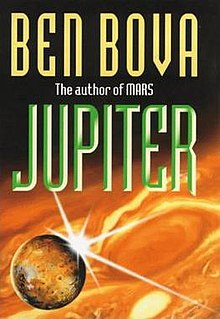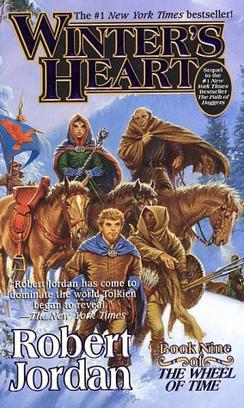
Winter's Heart is a fantasy novel by American author Robert Jordan, the ninth book of his series Wheel of Time. It was published by Tor Books and released on November 7, 2000. Upon its release, it immediately rose to the #1 position on the New York Times hardcover fiction bestseller list, making it the second Wheel of Time book to reach the #1 position on that list. It remained on the list for the next two months. Winter's Heart consists of a prologue and 35 chapters.
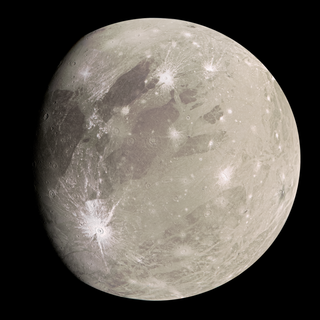
Ganymede, or Jupiter III, is the largest and most massive natural satellite of Jupiter and in the Solar System. It is the largest Solar System object without a substantial atmosphere, despite being the only moon in the Solar System with a substantial magnetic field. Like Titan, Saturn's largest moon, it is larger than the planet Mercury, but has somewhat less surface gravity than Mercury, Io, or the Moon due to its lower density compared to the three.

2061: Odyssey Three is a science-fiction novel by the British writer Arthur C. Clarke, published in 1987. It is the third book in Clarke's Space Odyssey series. It returns to one of the lead characters of the previous novels, Heywood Floyd, and his adventures from the 2061 return of Halley's Comet to Jupiter's moon Europa.

The Dragon Reborn is a fantasy novel by American writer Robert Jordan, the third in his series The Wheel of Time. It was published by Tor Books and released on September 15, 1991. The unabridged audio book is read by Michael Kramer and Kate Reading. The Dragon Reborn consists of a prologue and 56 chapters.
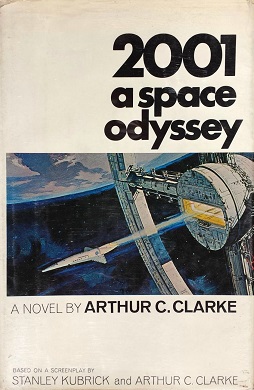
2001: A Space Odyssey is a 1968 science fiction novel by British writer Arthur C. Clarke. It was developed concurrently with Stanley Kubrick's film version and published after the release of the film. Clarke and Kubrick worked on the book together, but eventually only Clarke ended up as the official author. The story is based in part on various short stories by Clarke, including "The Sentinel". By 1992, the novel had sold three million copies worldwide. An elaboration of Clarke and Kubrick's collaborative work on this project was made in the 1972 book The Lost Worlds of 2001.

Manifold: Space is a science fiction book by British author Stephen Baxter, first published in the United Kingdom in 2000, then released in the United States in 2001. It is the second book of the Manifold series and examines another possible solution to the Fermi paradox. Although it is in no sense a sequel to the first book it contains a number of the same characters, notably protagonist Reid Malenfant, and similar artefacts. The Manifold series contains four books, Manifold: Time, Manifold: Space, Manifold: Origin, and Phase Space.

The Last Enchantment is a 1979 fantasy novel by Mary Stewart. It is the third in a quintet of novels covering the Arthurian legend, preceded by The Hollow Hills and succeeded by The Wicked Day.
The Grand Tour is a series of novels written by American science fiction author Ben Bova.

Far Horizons: All New Tales from the Greatest Worlds of Science Fiction is an anthology of original science fiction stories edited by Robert Silverberg, first published in hardcover by Avon Eos in May 1999, with a book club edition following from Avon and the Science Fiction Book Club in July of the same year. Paperback and trade paperback editions were issued by Eos/HarperCollins in May 2000 and December 2005, respectively, and an ebook edition by HarperCollins e-books in March 2009. The first British edition was issued in hardcover and trade paperback by Orbit/Little Brown in June 1999, with a paperback edition following from Orbit in July 2000.

The Icarus Hunt is a science fiction novel by American writer Timothy Zahn. It was first published in hardcover in August 1999, and was released in paperback in July 2000. It is an homage to the thriller novels of Alistair MacLean.

The magnetosphere of Jupiter is the cavity created in the solar wind by Jupiter's magnetic field. Extending up to seven million kilometers in the Sun's direction and almost to the orbit of Saturn in the opposite direction, Jupiter's magnetosphere is the largest and most powerful of any planetary magnetosphere in the Solar System, and by volume the largest known continuous structure in the Solar System after the heliosphere. Wider and flatter than the Earth's magnetosphere, Jupiter's is stronger by an order of magnitude, while its magnetic moment is roughly 18,000 times larger. The existence of Jupiter's magnetic field was first inferred from observations of radio emissions at the end of the 1950s and was directly observed by the Pioneer 10 spacecraft in 1973.
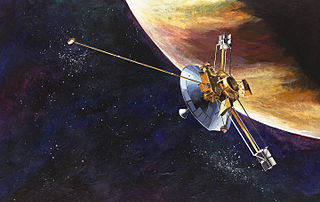
The exploration of Jupiter has been conducted via close observations by automated spacecraft. It began with the arrival of Pioneer 10 into the Jovian system in 1973, and, as of 2023, has continued with eight further spacecraft missions in the vicinity of Jupiter. All of these missions were undertaken by the National Aeronautics and Space Administration (NASA), and all but two were flybys taking detailed observations without landing or entering orbit. These probes make Jupiter the most visited of the Solar System's outer planets as all missions to the outer Solar System have used Jupiter flybys. On 5 July 2016, spacecraft Juno arrived and entered the planet's orbit—the second craft ever to do so. Sending a craft to Jupiter is difficult, mostly due to large fuel requirements and the effects of the planet's harsh radiation environment.

Son of the Shadows is a historical fantasy novel by Juliet Marillier and the second book in the Sevenwaters Trilogy first published in 2000. It follows the path of Sorcha and Red's third child, Liadan, a girl who lives outside the pattern of the 'Fair Folk', also known as Túatha Dé Danann. Son of the Shadows won the 2001 Aurealis Awards for Fantasy Novel.

The Precipice is a science fiction novel by Hugo Award winner Ben Bova. This novel is part of the Grand Tour series of novels. It is the first book in The Asteroid Wars series. It was first published in 2001. The title "The Precipice" refers to the "greenhouse cliff", or the ultimate collapse of Earth's biosphere, preceded by the steady encroachment of climate change.

Singularity's Ring is the debut science fiction book by Paul Melko. The novel was published on February 5, 2008 by Tor Books.

The exploration of Io, Jupiter's innermost Galilean and third-largest moon, began with its discovery in 1610 and continues today with Earth-based observations and visits by spacecraft to the Jupiter system. Italian astronomer Galileo Galilei was the first to record an observation of Io on January 8, 1610, though Simon Marius may have also observed Io at around the same time. During the 17th century, observations of Io and the other Galilean satellites helped with the measurement of longitude by map makers and surveyors, with validation of Kepler's Third Law of planetary motion, and with measurement of the speed of light. Based on ephemerides produced by astronomer Giovanni Cassini and others, Pierre-Simon Laplace created a mathematical theory to explain the resonant orbits of three of Jupiter's moons, Io, Europa, and Ganymede. This resonance was later found to have a profound effect on the geologies of these moons. Improved telescope technology in the late 19th and 20th centuries allowed astronomers to resolve large-scale surface features on Io as well as to estimate its diameter and mass.
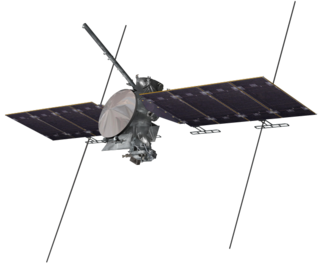
Europa Clipper is a space probe in development by NASA. Planned for launch in October 2024, the spacecraft is being developed to study the Galilean moon Europa through a series of flybys while in orbit around Jupiter. It is the largest spacecraft NASA has ever developed for a planetary mission.

Fool's Run is a science fiction novel by Patricia A. McKillip. It was first published in hardcover by Warner Books in April 1987, with a paperback edition issued by Questar/Popular Library in February 1988. The first British edition was published in paperback by Orbit in June 1987, with a hardcover edition following from Macdonald in August of the same year. The novel has also been translated into Italian.

The Sorceress and the Cygnet is a fantasy novel by Patricia A. McKillip. It was first published in hardcover by Ace Books in May 1991, with a paperback edition following from the same publisher in January 1992. The first British edition was published in hardcover and trade paperback by Pan Books in June 1991, with a standard paperback edition following from the same publisher in May 1992. It was subsequently combined with its sequel The Cygnet and the Firebird into the omnibus collection Cygnet, issued in trade paperback by Ace Books in March 2007.

The Galileo and Ulysses Dust Detectors are almost identical dust instruments on the Galileo and Ulysses missions. The instruments are large-area highly reliable impact ionization detectors of sub-micron and micron sized dust particles. With these instruments the interplanetary dust cloud was characterized between Venus’ and Jupiter's orbits and over the solar poles. A stream of interstellar dust passing through the planetary system was discovered. Close to and inside the Jupiter system streams nanometer sized dust particles that were emitted from volcanoes on Jupiter's moon Io and ejecta clouds around the Galilean moons were discovered and characterized.
